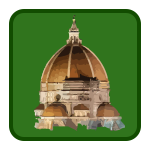Is it possible after spending an entire day in museums and basilicas that I want to go back for so much more? That’s the current mood. We started with lines. As I’ve heard is unavoidable, we stood in line for about 90 minutes just to get into the museums. It was well worth the wait, but that’s foreshadowing.
The mistake I keep bringing up for my semester is that I’m not listening to the advice people are giving me. In this case, it’s a suggestion Dr. Enos gave me for anywhere I go. He suggested a series called the “Blue Book” guides, which not only give places to go and great walking tours, but put in detailed accounts of the histories and current info of each spot. Jeremy, our wonderful guide, was using his for Rome. My mistake was that I didn’t pick one up for either Florence, Rome or the Vatican. There is SO much to take in that the book would have definitely helped me.
When we first got into the museums, Jeremy took us into a section off to the right that’s skipped by most of the big tours (thankfully). The Vatican Painting Gallery (Pinacoteca Vaticana) was loaded with some of the most important pieces in the history of painting’s evolution from wood to fresco to canvas surfaces with the mediums of tempura (egg yolk with ground color) all the way to oil. We saw pieces by Caravaggio, Giotto and so many others.
Then came the part where Jeremy released us and we could go through the rest of the museums we wanted to (like that was actually possible in that time frame — but that’s a given) before meeting him at the Obelisk in St. Peter’s Square. I had no idea where I was going, except that I didn’t like the huge tour groups, so I started following the Roman numerals in ascending order once I got inside each museum. I know, what a concept — learning Roman numerals actually helped me!
When I got to the Cortile Del Belvedere I saw some of the famous statues which I’d read about before. They were impressive, but the tour groups around them were huge, so I stayed for short moments. Then I found it: the Etruscan museum! While the Etruscans aren’t an exciting historical civilization for most people, I’ve done enough side readings related to my Classical Studies minor to know that the Etruscans were important. No, they’re not as famous as the Greeks, but for some reason, the Etruscans got a lot of stuff right before the Roman Republic and Empire sprang up. For instance, the Etruscans (contemporaries of the classical Greeks) had a culture where women and men had equality in terms of doing business and for their roles in society! Anyway, the Etruscan museum seemed like my own place when I went in. There were some people ahead of me, but as I looked at the sarcophagi and the statues they were always off in the distance. The museum personnel were nice, however, and smiled whenever I moved to the next room. When I started looking back I saw that they were shutting off each room and exhibit once I left. They weren’t rushing me, though; I could look as long as I wanted!
There were several parts of the Etruscan works that I loved. First, was something the museum couldn’t provide: I was listening to my iPod and turned on and completed Dvorak’s Symphony No. 9 (“From the New World”). It’s been my favorite for 7 years or so and hearing it put me in the mood to appreciate what I was looking at! The music was definitely not written for looking at Etruscan artifacts, but it worked. The music was actually written in Iowa when Dvorak (a Czech) had just come over to America for some extended periods.
So listening to the french horns’ great sections I was going through the statues. Listening to the beautiful clarinets in the Largo movement I was looking through the pottery and the little figurines made out of some type of metal. The symphony finally ended when I was getting ready to go into the Stanza della Segnatura. Sure enough, I didn’t beat the closing for it, and so I missed out on Raphael’s masterpiece, Philosophy (or “School of Athens”) where he shows most of the famous philosophers from the classical period with the portraits of many of his contemporaries (like Da Vinci).  Oh well, there’ll always be another time.
Oh well, there’ll always be another time.
I made it to the Sistine Chapel, and while it was impressive, the crowds drove me nuts. The great thing about big cities (which partially make me want to live in Rome sometime in my life) is that they offer SO much to see and do. The downside is that the reason they’re big is because they have people – lots of them! So the Chapel was packed and I decided to get the Michelangelo and Raphael book that the Vatican sold detailing all of the works and even some that I didn’t see.
Looking back, my favorite work of the entire day that I saw was Raphael’s “Transfiguration.” It tells so much of the story in such a good way (which was the main requirement of the paintings) that I pulled out details from the gospel narratives that I barely remembered reading. So good!
We finished off the afternoon with Jeremy explaining the genius of Bernini for designing the Piazza of St. Peter in order to make the Basilica seem even larger. When we got on the inside he showed us even more. While St. Peter’s is amazing and so nice and huge, I actually prefer the more intimate churches I’ve seen. Then again, when you have five million people going through there for John Paul II’s funeral, all the space that the church can give is crucial! It’s a wonderful place, just not my favorite.
The TCU crowd is going to a restaurant Dr. Antrim recommended to us (Cul de Sac) near our hotel tonight. Nap time for now!








Speak Your Mind
You must be logged in to post a comment.